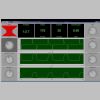Following the list of specific alternatives, there is a section on literature that either explains or evaluates the alternatives or provides additional information on the subject of anesthesia instruction.
If you are aware of other examples you believe to be important to include here, please send the information to HEVM for consideration.
New addition:
Human patient simulator

Modell et al 2014 used a human patient simulator from CAE Healthcare to train veterinary medical students in anesthesia and complications that may occur. They concluded that …the human patient simulator was a valuable learning tool for students of veterinary medicine. It was exciting for the students to work with, made them deal with ‘real-life’ scenarios, permitted them to learn without subjecting live patients to complications, enabled them to retrace their steps when their therapy did not correct the simulated patient’s problems, and facilitated correlation of their basic science knowledge with clinical data, thus accelerating their ability to handle complex clinical problems in healthy and diseased patients.
Virtual Ventilator

Developed by Dr RD Keegan at Washington State University College of Veterinary Medicine. The reactive computer simulation provides initial training that has been shown to prepare students for live animal experience better than traditional labs. You may be able to contact Dr Keegan directly for more information. He and his colleagues have published an evaluation report in Keegan et al 2012.
The following includes literature cited above or which is relevant to training in anesthesia. The titles are linked either to a publicly available copy of the document or to a digital object identifier. If there are illustrations which may be publicly viewable, these are also linked, but there is no guarantee that they would be viewable across all platforms.
Ertelt, Katrin; Turkovic, Veljko and Moens, Yves 2016 Clinical practice of epidural puncture in dogs and cats assisted by a commercial acoustic puncture assist device–epidural locator: preliminary results Journal of Veterinary Medical Education 43(1):21-25
 |
The study results showed that the APAD-EL information supports the subjective signs of correct needle placement suggested by positive POP and LOR experienced by trained anesthetists. The technique can be useful to assist difficult epidural puncture and as a training and teaching tool.
You may be able to obtain a copy of the paper from: ResearchGate
Freeman, Lynetta J.; Huse, David; Lee, Rebecca; Inoue, Tomo; Weil, Ann B. and Constable, Peter D. 2014 Teaching veterinary anesthesia and surgery: The impact of instructor availability on anesthesia, operative, and recovery times in dogs undergoing ovariohysterectomy or castration Journal of Veterinary Medical Education 41(4):390-399
Using dedicated instructors to teach OVH and castration to third-year veterinary students decreased overall anesthesia time by 36 to 49 minutes for OVH and 29 to 32 minutes for castration. A teaching model of dedicated instructors requires excellent coordination between surgeons and anesthesiologists to ensure that a similar number of animals can undergo procedures in the time allotted for teaching.
You may be able to obtain a copy of the paper from: ResearchGate
Jones, Jana L.; Rinehart, Jim; Spiegel, Jacqueline Jordan; Englar, Ryane E.; Sidaway, Brian K. and Rowles, Joie 2018 Teaching tip: Development of veterinary anesthesia simulations for pre-clinical training: Design, implementation, and evaluation based on student perspectives Journal of Veterinary Medical Education 45(2):232-240
Jones, Jana L.; Rinehart, Jim and Englar, Ryane E. 2019 The effect of simulation training in anesthesia on student operational performance and patient safety Journal of Veterinary Medical Education 46(2):205-213
Our findings suggest that students who were given the opportunity to participate in anesthesia-focused simulations before a live-animal anesthesia encounter demonstrated significant improvements in anesthesia operational performance and improved patient safety.
Keegan, Robert; Henderson, Tom and Brown, Gary 2009 Use of the Virtual Ventilator, a screen-based computer simulation, to teach the principles of mechanical ventilation Journal of Veterinary Medical Education 36(4):436-443
 |
Keegan, Robert D.; Brown, Gary R. and Gordon, Aifang 2012 Use of a simulation of the ventilator-patient interaction as an active learning exercise: Comparison with traditional lecture Journal of Veterinary Medical Education 39(4):359-367
 |
Was not used as a replacement to a live animal lab, only to augment a traditional lecture-based program.
Examination scores and opinions from 41 students enrolled in the third year (fifth semester) of the professional veterinary program at Washington State University (WSU) were evaluated to determine the effectiveness and utility of the Virtual Ventilator ICU simulation prototype for teaching principles of mechanical ventilation.
Upper-ranking students who learned the clinical topic through the simulation scenarios outperformed students who learned by traditional lecture. In addition, upper-ranking students scored higher than lower-ranking students in both the clinical and long-term composite examinations.
Keets, Lynn; Boscan, Pedro; Arakaki, Logan; Schraeder, Benjamin; Tornatzky, Cyane; Vans, Marie; Jiang, Wenjing and Rao, Sangeeta 2024-06-01 Interactive Virtual Reality with Educational Feedback Loops to Train and Assess Veterinary Students on the Use of Anesthetic Machine Journal of Veterinary Medical Education 51(3):412-420
Students learned and trained how to use the anesthesia machine components and connections and performed safety checks (such as the pressure check) using real and VR machines. … Prior VR experience was not necessary to train using VR. Computer glitches and cybersickness are important drawbacks to consider when using VR for education. The study demonstrated that interactive, immersive VR received favorable reactions from students. The VR incorporated educational feedback loops can be utilized as a simulation trainer for veterinary education. However, inherent limitations should be considered.
Modell, Jerome H.; Cantwell, Shauna; Hardcastle, John; Robertson, Sheilah and Pablo, Luisito 2002 Using the human patient simulator to educate students of veterinary medicine Journal of Veterinary Medical Education 29(2):111-116
We conclude that the human patient simulator was a valuable learning tool for students of veterinary medicine. It was exciting for the students to work with this simulator, which made them deal with ‘real-life’ scenarios, permitted them to learn without subjecting live patients to complications, enabled them to retrace their steps when their therapy did not correct the simulated patient’s problems, and facilitated correlation of their basic science knowledge with clinical data, thus accelerating their ability to handle complex clinical problems in healthy and diseased patients.
Musk, Gabrielle C.; Collins, Teresa and Hosgood, Giselle 2017 Teaching veterinary anesthesia: A survey-based evaluation of two high-fidelity models and live-animal experience for undergraduate veterinary students Journal of Veterinary Medical Education 44(4):590-602
Veterinary students completed a series of four surveys over the period of their pre-clinical training to evaluate the usefulness of high-fidelity models for skill acquisition in endotracheal intubation and intravenous catheterization. … The curriculum during this period of training progressed from lectures and non-animal training, to anesthesia of pigs undergoing surgery from which they did not recover, and finally to anesthesia of dogs and cats in a neutering clinic. The level of confidence for each of the three clinical skills increased over the study period. … The high-fidelity models for endotracheal intubation and intravenous catheterization used to complement the live-animal teaching were considered a useful adjunct to the teaching of clinical skills in veterinary anesthesia.
Phillips, Sierra and Burnett, Mindy 2024-05-01 Anesthesia simulation training at the University of Arizona College of Veterinary Medicine Journal of the American Veterinary Medical Association 262(5):712
Simulation training helps students develop skills in a diverse range of anesthesia tasks. From pressure-checking anesthesia machines to executing complex procedures, students are guided through a spectrum of simulated scenarios designed to enhance their technical proficiency and decision-making abilities. They have found that this immersive approach not only bolsters technical proficiency but also instills a sense of confidence and preparedness. Simulation-based training provides a safe and controlled environment for students to hone their skills, make mistakes, and learn without risk to patients. Students are better prepared to meet the demands of modern veterinary practice when they engage in surgical and anesthesia simulations.
Wilson, D.V. and Sneed, S. 1992 The use of interactive computer-based case simulations to teach veterinary anesthesia Journal of Veterinary Medical Education 19(4):164
A number of interactive, problem-based anesthesia case simulations (ACS) were designed as part of the veterinary anesthesia course. The ACS cover a range of different disease syndromes, different species, and related anesthetic challenges including a dog with head trauma, a foal with a ruptured bladder, a horse with colic, and a Great Dane with bloat. Each case includes an introduction to an animal and its disease history, specific pathophysiology, and actual anesthetic techniques. A significant effort has been made in all of the cases to maintain participant interest with animation, graphics, and required interaction. These simulations allow the student to manage difficult cases [sic] and associated problems that may occur. The diagnostic and therapeutic choices help to develop problem-solving techniques and reinforce important facts to be retained. Poor case [sic] management is marked by patient death, arrhythmias, or other less than optimal outcomes. A good choice is usually followed by a good outcome, but in some instances another problem will develop despite the best of care, just as in real life. … Student performance in the final exam was equivalent to that of conventionally taught students from the previous year.
Updated 2024-06-17
